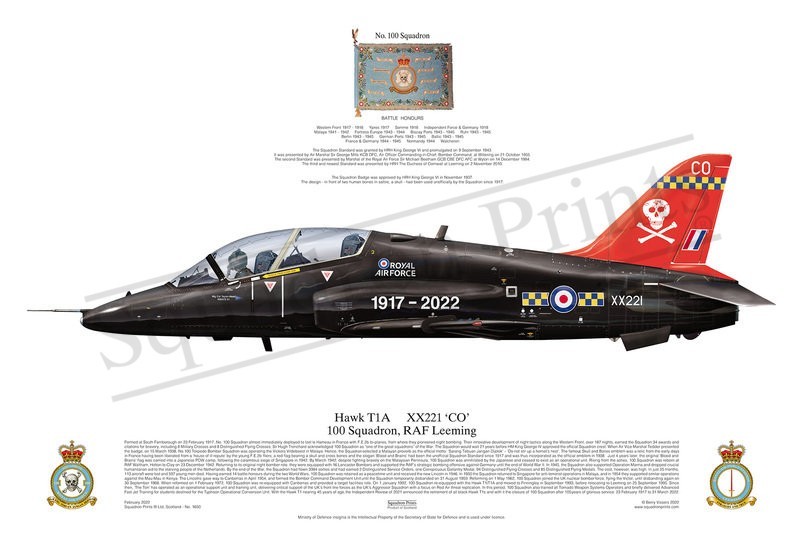#1650 100 Sqn Hawk T1 Squadron Print

Description
Squadron Prints Lithograph No. 1650 - XX221 'CO', Hawk T1A, 100 Squadron, RAF Leeming.
Formed at South Farnborough on 23 February 1917, No. 100 Squadron almost immediately deployed to Izel le Hameau in France with F.E.2b bi-planes, from where they pioneered night bombing. Their innovative development of night tactics along the Western Front, over 187 nights, earned the Squadron 34 awards and citations for bravery, including 8 Military Crosses and 8 Distinguished Flying Crosses; Sir Hugh Trenchard acknowledged 100 Squadron as “one of the great squadrons” of the War. The Squadron would wait 21 years before HM King George IV approved the official Squadron crest. When Air Vice Marshal Tedder presented the badge, on 15 March 1938, No.100 Torpedo Bomber Squadron was operating the Vickers Vildebeest in Malaya. Hence, the Squadron selected a Malayan proverb as the official motto: ‘Sarang Tebuan Jangan Dijolok’ – ‘Do not stir up a hornet’s nest’. The famous Skull and Bones emblem was a relic from the early days in France having been liberated from a ‘house of ill repute’ by the young F.E.2b fliers; a red flag bearing a skull and cross bones and the slogan ‘Blood and Brains’ had been the unofficial Squadron Standard since 1917 and was thus incorporated as the official emblem in 1938. Just 4 years later, the original ‘Blood and Brains’ flag was carried into a Japanese POW camp, following the calamitous siege of Singapore in 1942. By March 1942, despite fighting bravely on the Malaysian Peninsula, 100 Squadron was annihilated by the Japanese and ceased to exist as an operational unit. Rising from the ashes, 100 Squadron was reborn at RAF Waltham, Holton-le-Clay on 23 December 1942. Returning to its original night bomber role, they were equipped with 16 Lancaster Bombers and supported the RAF’s strategic bombing offensive against Germany until the end of World War II. In 1945, the Squadron also supported Operation Manna and dropped crucial humanitarian aid to the starving people of the Netherlands. By the end of the War, the Squadron had flown 3984 sorties and had earned 2 Distinguished Service Orders, one Conspicuous Gallantry Medal, 94 Distinguished Flying Crosses and 85 Distinguished Flying Medals. The cost, however, was high. In just 25 months, 113 aircraft were lost and 597 young men died. Having earned 14 battle-honours during the two World Wars, 100 Squadron was retained as a peacetime unit and received the new Lincoln in 1946. In 1950 the Squadron returned to Singapore for anti-terrorist operations in Malaya, and in 1954 they supported similar operations against the Mau-Mau in Kenya. The Lincolns gave way to Canberras in April 1954, and formed the Bomber Command Development Unit until the Squadron temporarily disbanded on 31 August 1959. Reforming on 1 May 1962, 100 Squadron joined the UK nuclear bomber force, flying the Victor, until disbanding again on 30 September 1968. When reformed on 1 February 1972, 100 Squadron was re-equipped with Canberras and provided a target facilities role. On 1 January 1992, 100 Squadron re-equipped with the Hawk T1/T1A and moved to Finningley in September 1993, before relocating to Leeming on 25 September 1995. Since then, ‘The Ton’ has operated as an operational support unit and training unit, delivering critical support of the UK’s front line forces as the UK’s Aggressor Squadron with a focus on Red Air threat replication. In this period, 100 Squadron also trained all Tornado Weapon Systems Operators and briefly delivered Advanced Fast Jet Training for students destined for the Typhoon Operational Conversion Unit. With the Hawk T1 nearing 45 years of age, the Independent Review of 2021 announced the retirement of all black Hawk T1s and with it the closure of 100 Squadron after 105 years of glorious service: 23 February 1917 to 31 March 2022.
You may also like
-
Marine Aircraft Group 13
165001 '01'; 169416 '01'; 169590 '03'; 169679 '01'; 164566 '01'; 169368VMA-311; VMFA-122; VMA-214; MAG-3, MALS-13; MAG-13; VMFA-211; VMFA-225; VMU-1MCAS Yuma, Arizona -
Available sizes
Small , Medium , Large , XL -
"Union of South Africa" Gresley A4 Class Train
60009; Gresley 4-6-2 A4 Class TrainUnion of South Africa
